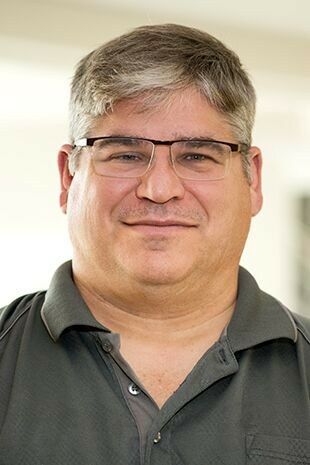The chemistry faculty recognizes the power of modern instrumentation in dealing with the problems fundamental to the study of chemistry both in the academic and industrial settings. Today any student graduating without proper training in and access to modern instrumentation is at a decided disadvantage. The department possesses a wide range of instrumental equipment for use by our students in laboratory courses and research projects. Major pieces of instrumental equipment are listed below.
In addition, the department is well stocked with standard laboratory equipment including analytical balances, pH meters, Mel-Temps, Bausch and Lomb Spectronic ’20s, rotary evaporators, refrigerators, vacuum pumps, drying ovens, calorimeters, osmometer, and a magnetic susceptibility balance.
Nuclear Magnetic Resonance (NMR) Flame Atomic Absorption Spectrometer (FAAS) Inductively Coupled Plasma Optical Emission Spectrometer (ICP-OES) UV/Visible Spectrometers Fourier Transform Infrared Spectrophotometers (FTIR) High Performance Liquid Chromatography (HPLC) Gas Chromatograph (GC) Gas Chromatography Mass Spectrometer (GC-MS) AFM/STM Langmuir Troughs Cyclic Voltammeter/Potentiostat (CV) Polarized Light Microscopes (PLMs) Polarimeter Refractometer Muffle Furnace Computational Chemistry Schlenk Line and Glove Box Nuclear Magnetic Resonance (NMR)
The department has a Varian Inova 400 MHz Widebore Nuclear Magnetic Resonance (NMR) spectrophotometer equipped with an autosampler. This technique is critical in chemistry, allowing us to identify the structural backbone of molecules. Students first encounter the NMR in Organic Chemistry I (CHM 160). They use it in a variety of courses including Organic Chemistry II (CHM 170), Intermediate Organic (CHM 320), Advanced Synthesis Laboratory (CHM 380), Chemical Measurements (CHM 385), and Independent Study (CHM 500/501).
Research by students involving the NMR has appeared in publications in the peer-reviewed journals Tetrahedron Letters (Papers I and II) and Magnetic Resonance in Chemistry.
The NMR was purchased through a Major Research Instrumentation Grant from the National Science Foundation (CHE-0535656) with more recent support provided by a generous donation from the Anderson Family.
Flame Atomic Absorption Spectrometer (FAAS)
The flame atomic absorption spectrometer (FAAS) can detect the presence of metals in a sample. Our FAAS (Perkin Elmer 3110) has been used in Chemical Measurements (CHM 385), Analytical Chemistry (CHM 270), and Independent Study (CHM 500/501). The FAAS determined what metals were present in mysterious-looking graveyard artifacts obtained from the ancestral cemetery of a W&J alum as well as the ability of banana peels to absorb lead. Analytical Chemistry (CHM 270) students have also used the FAAS to determine the amount of lead present in ancient Roman coins.
Inductively Coupled Plasma Optical Emission Spectrometer (ICP-OES)
Our inductively coupled plasma optical emission spectrometer (ICP-OES, ThermoFisher iCAP 6300) can detect the presence of metals in a sample, indicating how much of a particular metal atom is present. The ICP-OES has been used in a variety of courses, including Chemical Measurements (CHM 385), Analytical Chemistry (CHM 270), and Independent Study (CHM 500/501). The ICP, for example, has been used to determine if heavy metals are present in children’s toys and investigate whether or not regional groundwater has been contaminated by natural gas extraction through hydrofracking. It has also been used in research on nanoparticle coating and modification.
UV/Visible Spectrometers
The department owns several UV/Vis spectrometers, including two Perkin-Elmer Lambda 25 models, one Perkin-Elmer Lambda 35 model, and three ThermoElectron Evolution 60 instruments.
A UV/Vis spectrometer can measure the amount of ultraviolet (UV) or visible (Vis) light that a compound absorbs. Such information can, in turn, be used to determine how much of a particular substance is present in a sample. Students in Analytical Chemistry (CHM 270), for example, used UV/Vis to measure the amount of iron or phosphorus in groundwater to determine if Marcellus Shale Gas Development has had a detrimental effect on streams. Non-science majors in Laboratory Excursions in Food Chemistry (Intersession) determined the amount of FD&C dyes in Kool-Aid while Introduction to Inorganic Chemistry (CHM 260) students measured the equilibrium constant of an iron complex reaction. The UV/Vis also allows our students in Biochemistry (BCH 333) to assess the kinetics of enzyme activity.
Fourier Transform Infrared Spectrophotometers (FTIR)
The department is equipped with 3 ThermoElectron IR200 Fourier Transform Infrared (FTIR) spectrophotometers as well as a research-grade ThermoElectron Nexus FTIR. IR enables us to determine the functional groups present in molecules, allowing us to identify the components in a sample. The FTIR is frequently used in Organic Chemistry I and II (CHM 160/170) and Advanced Synthesis Laboratory (CHM 380). These instruments have also been a part of The Art Conservation of Paintings (CHM 330) and Independent Study (CHM 500/501) projects, with student results appearing in publications in Tetrahedron Letters (Papers I and II).
Some of the funding for acquiring the FTIR instruments came from the Spectroscopy Society of Pittsburgh with matching funds provided by W&J. As part of our FTIR instrumentation, we have attenuated total reflectance (ATR) and direct reflectance accessories.
High-Performance Liquid Chromatography (HPLC)
High-Performance Liquid Chromatography (HPLC) is a technique by which solutions can be separated into their components. Our students use the HPLC (Varian ProStar with autosampler) in Analytical Chemistry (CHM 270) to determine how hot a hot sauce is. The components of suntan lotion are also examined in Chemical Measurements (CHM 385).
The HPLC has been used in Independent Study (CHM 500/501) to measure the number of alpha acids present in hops, important in controlling the taste in home-brewed beer.
Gas Chromatograph (GC)
The Gas Chromatograph (GC) (Varian CP 3800 with autosampler) detects the components in a mixture using a flame ionization detector (FID) and thermal conductivity detector (TCD). Analytical Chemistry (CHM 270) students used the GC to assess the amount of ethanol in whiskey, rum, and vodka. In addition, The Chemistry of Perfume (Intersession) nonscience majors ran GC to investigate how well a counterfeit perfume mimicked a designer one. Organic Chemistry II (CHM 170) students also use GC to analyze their alkene products in an alcohol dehydration reaction.
Gas Chromatography Mass Spectrometer (GC-MS)
The Gas Chromatography Mass Spectrometer (GC-MS) (Varian GC 431/MS 220 with autosampler) allows us to analyze the components in a mixture and determine what, exactly, they are. Since these samples need to be volatile (or gaseous), the GC-MS is particularly useful in flavor and fragrance analysis.
Our GC-MS is used by Analytical Chemistry (CHM 270) students to investigate the trace amount of cocaine found on money. Students in The Art Conservation of Paintings (Intersession) used the GC-MS to assess the age of various paintings.
The GC-MS was part of a recent art conservation research project in which a student examined the photochemistry of iron gall ink and how it corrodes parchment paper over time. In addition, GC-MS characterization of biologically relevant compounds synthesized by W&J students appeared in a publication in the Archive of Organic Chemistry.
AFM/STM
The Atomic Force Microsope (AFM) (Agilent 5500) allows us to image surfaces at the nanoscale. Students used the AFM in Chemical Measurements (CHM 385) to examine coating on nanoparticles. In addition, the AFM has been used by several research students to investigate the formation of polymer nanostructures (formed on our Langmuir trough), leading to a publication in Langmuir, an American Chemical Society peer-reviewed journal.
The instrument also has a scanning tunneling microscope (STM) module that allows us to “see atoms” and experimentally witness electron tunneling.
The AFM/STM were purchased through a Major Research Instrumentation grant from the National Science Foundation (DMR 0959373).
Langmuir Troughs
The Langmuir trough (KSV 2000) allows us to create films that are one molecule thick by spreading surfactants at an air/water interface. Surfactants are molecules that contain a hydrophobic “water-fearing” and hydrophilic “water-loving” part. W&J has two Langmuir troughs-one for air/water studies and another (special) one for oil/water studies.
The Langmuir trough is used in Independent Study (CHM 500/501). Students, for example, can prepare polymer nanostructures that can then be imaged using our atomic force microscope (AFM). Results of this research appeared in a publication in Langmuir, an American Chemical Society peer-reviewed journal. In addition, the Langmuir trough has been used to create lipid bilayers that mimic cell membranes.
Cyclic Voltammeter/Potentiostat (CV)
The cyclic voltammeter/potentiostat (CV, Bioanalytical Systems) measures the amount of current a sample conducts. The CV has most recently been used in Independent Study (CHM 500/501) to analyze the charge transfer effect of various coatings on nanoparticles. Understanding this phenomenon is important in solar cell development. The CV was also used in biochemistry research to develop a method for detecting enzyme activity.
Polarized Light Microscopes (PLMs)
The department has two polarized light microscopes (PLM) (Leica DM EP) that students can use to examine materials that interact with polarized light. PLM, for example, has been used in both The Art Conservation of Paintings (Intersession) and Science and Art (Intersession) to identify fibers found in a painting’s canvas. The PLM has also been used in Independent Study (CHM 500/501).
The PLMs have obtained thanks to a grant from the Spectroscopy Society of Pittsburgh.
Polarimeter
Our polarimeter measures how much an optically active compound can rotate polarized light. Many molecules that are important in the food or pharmaceutical industries display optical activity. The polarimeter can be used to determine their purity-a critical concern, for example, in the preparation of medicinal drugs. The polarimeter is part of Introduction to Inorganic Chemistry (CHM 260) where students characterize two cobalt complex isomers. A student also used the polarimeter to examine the kinetics of the brewing process of beer in an Independent Study (CHM 500/501).
The polarimeter was purchased through a grant from the Spectroscopy Society of Pittsburgh and matching funds from W&J.
Refractometer
Our refractometer measures the amount by which light is “bent” as it passes through a liquid. Known as the refractive index (RI), this property is characteristic of a material, allowing us to identify an unknown when its RI is measured. The refractometer is most widely used in Organic Chemistry I (CHM 160) and II (CHM 170).
The refractometer was purchased through a grant from the Spectroscopy Society of Pittsburgh and matching funds from W&J.
Muffle Furnace
Our benchtop muffle furnace (Thermo Scientific Thermolyne, model F48055-60) is important for the solid-state synthesis of inorganic materials. Students use this furnace in both Advanced Synthesis Laboratory (CHM 380) as well as in Independent Study (CHM 500/501). The programmable furnace has heating and cooling segment capabilities as well as an inlet for gas flow. Coupled with our hydraulic press for making powder pellets, students have synthesized materials with interesting electronic, magnetic, and/or optical properties such as superconductors, perovskites, spinels, and pyrochlores using this high temperature furnace.
Computational Chemistry
The department has computational chemistry and molecular modeling suite housed on 2 Dell PowerEdge linux servers. The software includes Gaussian03, Gaussview4, Accelerys Materials studio 5.0 (thanks to a collaboration with Penn State), a ChemDraw site license, and a Cambridge Crystallographical Database. Some of this software is also available in our Swanson Science Center computer lab. Students have used this software in both Independent Study (CHM 500/501) and Quantum Mechanics (CHM 370).
Results from research involving computational chemistry at W&J have been published in several peer-reviewed journals, including The Journal of Chemical Physics, the Journal of Physical Chemistry A (Papers I and II), Magnetic Resonance Chemistry, and Solid State Nuclear Magnetic Resonance.
Schlenk Line and Glove Box
Our Schlenk line and glovebox are useful when working with chemicals that are sensitive to air and humidity (water). The Schlenk line is a sophisticated piece of glassware connected to a vacuum pump and a dry unreactive gas like N2. The glove box (Innovative Technology, System One) contains an inert atmosphere where O2 and water vapor are removed. Both apparatuses allow students to manipulate sensitive chemicals and set up reactions that would fail if exposed to air. This equipment is routinely used in Advanced Synthesis Laboratory (CHM 380) and Independent Study (CHM 500/501).








